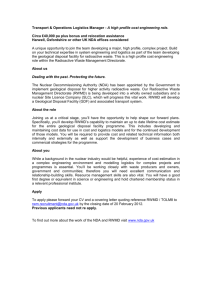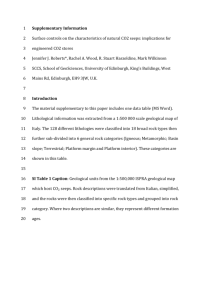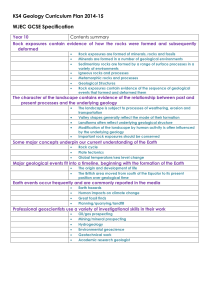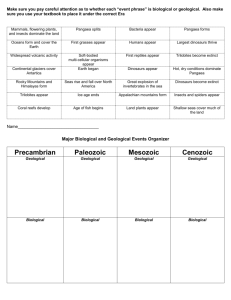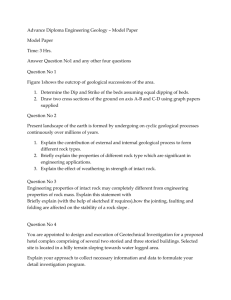Draft note for West Cumbria MRWS Partnership
advertisement
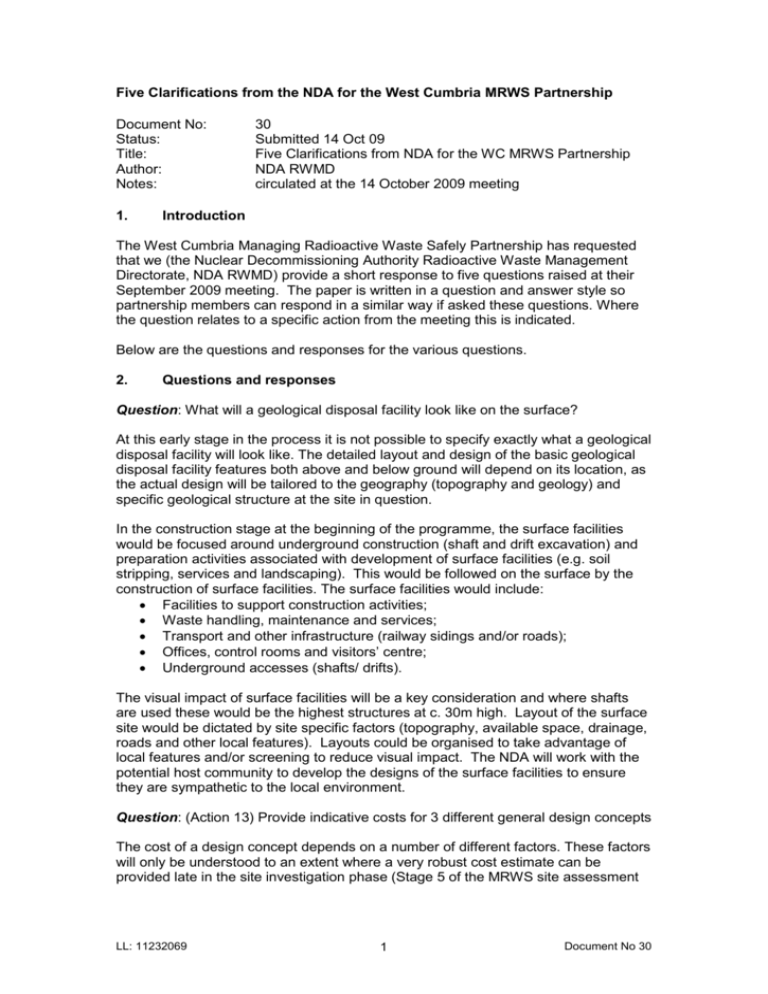
Five Clarifications from the NDA for the West Cumbria MRWS Partnership Document No: Status: Title: Author: Notes: 1. 30 Submitted 14 Oct 09 Five Clarifications from NDA for the WC MRWS Partnership NDA RWMD circulated at the 14 October 2009 meeting Introduction The West Cumbria Managing Radioactive Waste Safely Partnership has requested that we (the Nuclear Decommissioning Authority Radioactive Waste Management Directorate, NDA RWMD) provide a short response to five questions raised at their September 2009 meeting. The paper is written in a question and answer style so partnership members can respond in a similar way if asked these questions. Where the question relates to a specific action from the meeting this is indicated. Below are the questions and responses for the various questions. 2. Questions and responses Question: What will a geological disposal facility look like on the surface? At this early stage in the process it is not possible to specify exactly what a geological disposal facility will look like. The detailed layout and design of the basic geological disposal facility features both above and below ground will depend on its location, as the actual design will be tailored to the geography (topography and geology) and specific geological structure at the site in question. In the construction stage at the beginning of the programme, the surface facilities would be focused around underground construction (shaft and drift excavation) and preparation activities associated with development of surface facilities (e.g. soil stripping, services and landscaping). This would be followed on the surface by the construction of surface facilities. The surface facilities would include: Facilities to support construction activities; Waste handling, maintenance and services; Transport and other infrastructure (railway sidings and/or roads); Offices, control rooms and visitors’ centre; Underground accesses (shafts/ drifts). The visual impact of surface facilities will be a key consideration and where shafts are used these would be the highest structures at c. 30m high. Layout of the surface site would be dictated by site specific factors (topography, available space, drainage, roads and other local features). Layouts could be organised to take advantage of local features and/or screening to reduce visual impact. The NDA will work with the potential host community to develop the designs of the surface facilities to ensure they are sympathetic to the local environment. Question: (Action 13) Provide indicative costs for 3 different general design concepts The cost of a design concept depends on a number of different factors. These factors will only be understood to an extent where a very robust cost estimate can be provided late in the site investigation phase (Stage 5 of the MRWS site assessment LL: 11232069 1 Document No 30 process). Even at that stage it is to be expected that further information may influence that estimate. However, for planning purposes the NDA is developing 3 different concepts for differing geological environments. In order to undertake that process a number of assumptions have been made about the timing, the geology and about the concept in order to develop design concepts. Using the information used to develop the design concepts, indicative costs have been estimated. It is important to emphasise, though, that the process of implementing geological disposal will be dependent on discussions with local communities and that voluntarism and partnership are the key drivers in this process. Using the work that NDA has undertaken to date it is estimated that the cost of implementing a design concept in a higher strength rock and in an evaporate rock are very similar. If it is assumed that the baseline inventory, as identified in the Managing Radioactive Waste Safely White Paper (but excluding plutonium and uranium) is to be included in the concept then the cost is of the order of £12 billion (at 2008 money values and undiscounted). If the same inventory is assumed to be included in a concept for lower strength rock then the indicative costs would be expected to increase by circa £4 billion. If the inventory of plutonium and uranium as identified in the Managing Radioactive Waste Safely White Paper was included then these values would increase. The increase for the higher strength and evaporate rock would be of the order of £2 billion (total of circa £14 billion) and for lower strength rock would be of the order of £4 billion (total of circa £20 billion). The cost increases in lower strength rock because the underground openings cannot be as large as the other rock types and, as a result for the same waste inventory more openings are required. In addition to the increase in the number of openings, both infrastructure and emplacement facilities require more support to maintain them. The increased number of emplacement facilities result in a need for more equipment. Question: (Action 14) Investigate what is in the public domain about the number of jobs potentially associated with the repository and when more information may become public. The information about the number of jobs associated with repository development was released in September 2005 by Nirex to the Committee on Radioactive Waste Management (CoRWM). The document is entitled “Summary Note for CoRWM on the Distribution of Effort and Employment Profiles for the Deep Geological Disposal and the Phased Deep Geological Options”. The document can be accessed at: www.nda.gov.uk/documents/loader.cfm?url=/commonspot/security/getfile.cfm&pagei d=11870 Subsequent to this, a statement has been released by Alun Ellis, RWMD Project Director, outlined below: “The development of a geological disposal facility will create considerable employment opportunities. The employment needs will be very different during the different phases of the work. The largest employment opportunities will exist during the construction and operation phases of the development. It is expected that the peak employment will occur during the initial construction when up to 500 jobs will be created on the construction site. It is expected that the average number of jobs over an operating period of about 100 years will be between 200 and 300.” LL: 11232069 2 Document No 30 It is expected that more information may be available when a more detailed analysis of the implementation is undertaken. It is expected that the next analysis of manpower requirements will be undertaken when specific locations are identified where a potential geological disposal facility may be implemented. Question: Please give indicative timescales for the different stages of geological disposal. Government wants to build on the momentum the Committee on Radioactive Waste Management (CoRWM) helped establish and suggests that it is likely to be around two to three decades from the beginning of the site selection process to a facility becoming operational and ready for waste emplacement. It is important to emphasise, though, that the process will be dependent on discussions with local communities and that voluntarism and partnership are the key drivers in this process. The MRWS site assessment process is shown below. We are currently at Stage 1 of the MRWS site assessment process. The timescale for Stages 1-3 is dependent on the time required for discussions and decisions in LL: 11232069 3 Document No 30 communities who have expressed an interest. The Government is taking the lead for Stages 1-3, therefore this answer focuses on Stage 4 onwards. The following sections outline the steps that have been proposed to implement geological disposal grouped under the stages of the MRWS site assessment process: Stage 4: Desk-based studies in participating areas 1. Desk based studies Work in this stage is assumed to include: • Working in partnership with communities • Concept development • Maintain & update Baseline Inventory • Determine implications of material NOT presently considered as waste • Provide packaging advice This stage will end with Candidate sites identified to allow sites (assumed to be 2) to be investigated in detail. It is assumed that this will take about 2 years. Stage 5: Surface investigations on remaining candidates 2. Surface investigations Work in this stage is assumed to include: Working in partnership with communities • Obtaining planning permissions for the site investigations • Acquiring information on geological, hydrogeological and environmental conditions • Developing site specific safety cases • Continuing to provide packaging advice • Developing the Concept into designs This stage is assumed to end with a decision on the preferred site on which to build a geological disposal facility. This stage is assumed to take about 10 years, with a decision on a preferred site being taken by about 2025. Stage 6: Underground operations 3. Construction Work in this stage is assumed to include: • Working in partnership with the community • Obtaining Planning/Regulatory submissions and approvals to construct • Construction of facilities to enable emplacement • Investigations/testing & demonstrations to demonstrate performance • Refining design & regulatory submissions This stage is assumed to take about 15 years, with the first emplacement of Low Level Waste / Intermediate Level Waste taking place around 2040. The first emplacement of High Level Waste / Spent Fuel is assumed to be around 2075. LL: 11232069 4 Document No 30 4. Operation (and construction) Work in this stage is assumed to include: • Working in partnership with the community • Working with the site licence companies to ensure the operational period is aligned to their lifetime plans • Ongoing construction will be concurrent with operation, as required • Ensuring options for retrievability are built into the design This stage is assumed to take about 90 years, based on the inventory and the throughput rates. 5. Closure The decision on closure is assumed to be made in conjunction with all stakeholders. Work in this stage is assumed to include: • Decommissioning of all facilities • Backfilling of underground excavations • Placing records in the National Nuclear Archive • Following closure responsibility is assumed to be transferred to the authority charged with institutional control This stage is assumed to take about 10 years. LL: 11232069 5 Document No 30
